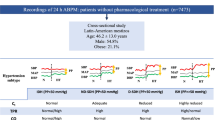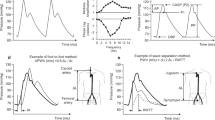Abstract
Central aortic systolic blood pressure (SBP-C) can be estimated from a cuff oscillometric waveform derived during the pulse volume plethysmography (PVP) by applying a device-specific aortic pressure-to-PVP waveform-generalized transfer function (A2PGTF). The present study compared the performance of an aortic-to-brachial pressure waveforms generalized transfer function (A2BGTF), which is independent of any PVP devices, with an A2PGTF. Generalized transfer function of aortic-to-brachial (A2BGTF) and aortic-to-PVP (A2PGTF) were generated from the simultaneously obtained central aortic and brachial pressure waveforms recorded by a high-fidelity dual pressure sensor catheter, and the PVP waveform recorded by a customized noninvasive blood pressure monitor during cardiac catheterization in 40 patients, and were then applied in another 100 patients with simultaneously recorded invasive aortic pressure and noninvasively calibrated (using cuff SBP and diastolic blood pressures) PVP waveforms. The mean difference±s.d. between the noninvasively estimated and invasively recorded SBP-C was −2.1±7.7 mm Hg for A2BGTF, which was not greater than that of −3.0±7.7 mm Hg for A2PGTF (P<0.01). In conclusion, SBP-C can be measured reliably using a noninvasive blood pressure monitor by applying either an A2PGTF or A2BGTF to a noninvasively calibrated PVP waveform. The performance of an A2BGTF is not inferior to that of an A2PGTF.
This is a preview of subscription content, access via your institution
Access options
Subscribe to this journal
Receive 12 digital issues and online access to articles
$119.00 per year
only $9.92 per issue
Buy this article
- Purchase on Springer Link
- Instant access to full article PDF
Prices may be subject to local taxes which are calculated during checkout




Similar content being viewed by others
References
Nichols WW, O'Rourke MF, Vlachopoulos C . McDonald's Blood Flow in Arteries: Theoretical, Experimental and Clinical Principles. 6th edn. Hodder Arnold: London, 2011.
Segers P, Mahieu D, Kips J, Rietzschel E, De Buyzere M, De Bacquer D et al. Amplification of the pressure pulse in the upper limb in healthy, middle-aged men and women. Hypertension 2009; 54(2): 414–420.
Smulyan H, Mukherjee R, Sheehe PR, Safar ME . Cuff and aortic pressure differences during dobutamine infusion: a study of the effects of systolic blood pressure amplification. Am Heart J 2010; 159(3): 399–405.
Mahmud A, Feely J . Spurious systolic hypertension of youth: fit young men with elastic arteries. Am J Hypertens 2003; 16(3): 229–232.
Cheng HM, Wang KL, Chen YH, Lin SJ, Chen LC, Sung SH et al. Estimation of central systolic blood pressure using an oscillometric blood pressure monitor. Hypertens Res 2010; 33(6): 592–599.
Sharman JE, Lim R, Qasem AM, Coombes JS, Burgess MI, Franco J et al. Validation of a generalized transfer function to noninvasively derive central blood pressure during exercise. Hypertension 2006; 47(6): 1203–1208.
Vlachopoulos C, Aznaouridis K, O'Rourke MF, Safar ME, Baou K, Stefanadis C . Prediction of cardiovascular events and all-cause mortality with central haemodynamics: a systematic review and meta-analysis. Eur Heart J 2010; 31(15): 1865–1871.
Williams B, Lacy PS . Central haemodynamics and clinical outcomes: going beyond brachial blood pressure? Eur Heart J 2010; 31(15): 1819–1822.
Papaioannou TG, Protogerou AD, Stamatelopoulos KS, Vavuranakis M, Stefanadis C . Non-invasive methods and techniques for central blood pressure estimation: procedures, validation, reproducibility and limitations. Curr Pharm Des 2009; 15(3): 245–253.
Smulyan H, Safar ME . Blood pressure measurement: retrospective and prospective views. Am J Hypertens. 2011; 24(6): 628–634.
Roman MJ, Devereux RB, Kizer JR, Lee ET, Galloway JM, Ali T et al. Central pressure more strongly relates to vascular disease and outcome than does brachial pressure: the Strong Heart Study. Hypertension 2007; 50(1): 197–203.
Pini R, Cavallini MC, Palmieri V, Marchionni N, Di Bari M, Devereux RB et al. Central but not brachial blood pressure predicts cardiovascular events in an unselected geriatric population: the ICARe Dicomano Study. J Am Coll Cardiol 2008; 51(25): 2432–2439.
Wang KL, Cheng HM, Chuang SY, Spurgeon HA, Ting CT, Lakatta EG et al. Central or peripheral systolic or pulse pressure: which best relates to target organs and future mortality? J Hypertens 2009; 27: 461–467.
Wassertheurer S, Kropf J, Weber T, van der Giet M, Baulmann J, Ammer M et al. A new oscillometric method for pulse wave analysis: comparison with a common tonometric method. J Hum Hypertens 2010; 24(8): 498–504.
Weber T, Wassertheurer S, Rammer M, Maurer E, Hametner B, Mayer CC et al. Validation of a brachial cuff-based method for estimating central systolic blood pressure. Hypertension 2011; 58(5): 825–832.
Climie RE, Schultz MG, Nikolic SB, Ahuja KD, Fell JW, Sharman JE . Validity and reliability of central blood pressure estimated by upper arm oscillometric cuff pressure. Am J Hypertens 2012; 25(4): 414–420.
Liu SH, Wang JJ, Wen ZC . Extraction of a new arterial stiffness index from oscillometry. J Med Biol Eng 2007; 27(3): 116–123.
Shih YT, Cheng HM, Sung SH, Hu WC, Chen CH . Quantification of the calibration error in the transfer function-derived central aortic blood pressures. Am J Hypertens 2011; 24(12): 1312–1317.
Kubo T, Miyata M, Minagoe S, Setoyama S, Maruyama I, Tei C . A simple oscillometric technique for determining new indices of arterial distensibility. Hypertens Res 2002; 25(3): 351–358.
Karamanoglu M, O'Rourke MF, Avolio AP, Kelly RP . An analysis of the relationship between central aortic and peripheral upper limb pressure waves in man. Eur Heart J 1993; 14: 160–167.
Chen CH, Nevo E, Fetics B, Pak PH, Yin FCP, Maughan WL et al. Estimation of central aortic pressure waveform by mathematical transformation of radial tonometry pressure: validation of generalized transfer function. Circulation 1997; 95: 1827–1836.
Pauca AL, O'Rourke MF, Kon ND . Prospective evaluation of a method for estimating ascending aortic pressure from the radial artery pressure waveform. Hypertension 2001; 38(4): 932–937.
Segers P, Mahieu D, Kips J, Van Bortel LM . The use of a generalized transfer function: different processing, different results!. J Hypertens 2007; 25(9): 1783–1787.
O'Rourke MF, Adji A . Clinical use of applanation tonometry: hope remains in Pandora's box. J Hypertens 2010; 28(2): 229–233.
Ursino M, Cristalli C . Mathematical modeling of noninvasive blood pressure estimation techniques--part I: pressure transmission across the arm tissue. J Biomech Eng 1995; 117(1): 107–116.
Wassertheurer S, Mayer C, Breitenecker F . Modeling arterial and left ventricular coupling for non-invasive measurements. Simulat Model Pract Theor 2008; 16: 988–997.
Papaioannou TG, Lekakis JP, Karatzis EN, Papamichael CM, Stamatelopoulos KS, Protogerou AD et al. Transmission of calibration errors (input) by generalized transfer functions to the aortic pressures (output) at different hemodynamic states. Int J Cardiol 2006; 110(1): 46–52.
Mahieu D, Kips J, Rietzschel ER, De Buyzere ML, Verbeke F, Gillebert TC et al. Noninvasive assessment of central and peripheral arterial pressure (waveforms): implications of calibration methods. J Hypertens 2010; 28(2): 300–305.
Association for the Advancement of Medical I. American National Standard. Electronic or Automated Sphygmomanometers. AAMI: Arlington, VA, 2009.
Lehmann KG, Gelman JA, Weber MA, Lafrades A . Comparative accuracy of three automated techniques in the noninvasive estimation of central blood pressure in men. Am J Cardiol 1998; 81(8): 1004–1012.
Acknowledgements
This work was supported in part by the National Science Council (NSC 96-2314-B-010-035-MY3, NSC 99-2314-B-010-034-MY3), Ministry of Education, Aim for the Top University Plan (96A-D-D131) and a research grant from an Industry-Academia Cooperation between Microlife Co., Ltd, and National Yang-Ming University.
Author information
Authors and Affiliations
Corresponding authors
Ethics declarations
Competing interests
Microlife Co., Ltd and National Yang-Ming University have signed a contract for transfer of the noninvasive central blood pressure technique.
Additional information
Supplementary Information accompanies the paper on the Journal of Human Hypertension website
Supplementary information
Rights and permissions
About this article
Cite this article
Shih, YT., Cheng, HM., Sung, SH. et al. Comparison of two generalized transfer functions for measuring central systolic blood pressure by an oscillometric blood pressure monitor. J Hum Hypertens 27, 204–210 (2013). https://doi.org/10.1038/jhh.2012.17
Received:
Revised:
Accepted:
Published:
Issue Date:
DOI: https://doi.org/10.1038/jhh.2012.17
Keywords
This article is cited by
-
Testing a Patient-Specific In-Silico Model to Noninvasively Estimate Central Blood Pressure
Cardiovascular Engineering and Technology (2021)
-
Estimation of Cardiovascular Risk Predictors from Non-Invasively Measured Diametric Pulse Volume Waveforms via Multiple Measurement Information Fusion
Scientific Reports (2018)
-
Central Blood Pressure Monitoring via a Standard Automatic Arm Cuff
Scientific Reports (2017)
-
Model-based cardiovascular disease diagnosis: a preliminary in-silico study
Biomechanics and Modeling in Mechanobiology (2017)
-
Electrocardiogram derived QRS duration associations with elevated central aortic systolic pressure (CASP) in a rural Australian population
Clinical Hypertension (2015)



